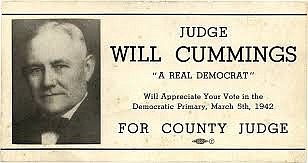Cummings Highway? Cummings Cove? Fifty-one years after his death, Will Cummings would be honored to learn that the Cummings name is still recognizable in the 21st century.
The three-term Hamilton County judge, considered one of the area's most influential men, claimed friends in high places. According to a news story published in the Chattanooga Post following his death in 1969, the judge enjoyed pulling out folders filled with personal letters from presidents, governors, members of Congress and business leaders. A political ally of President Franklin D. Roosevelt, the judge kept a special collection of FDR letters, including one addressing the judge as "Dear Will" while referencing a delightful dinner the president and friends had enjoyed at the Cummings home "on a hill in Wauhatchie." The menu, according to President Roosevelt, had included "quail, venison and other game bagged by the Judge on his frequent hunting trips."
Cummings often shared the facts of his humble beginnings as an example that success and hard work are intrinsically linked. Born in Marion County, he had attended a one-room school building at Kelly's Ferry, requiring a three-mile walk and a ferry ride across the Tennessee River each way. An excellent student, he later attended Winchester Normal School and the University of Tennessee.
At age 24, Cummings successfully campaigned for Hamilton County justice of the peace. Five years later, he was elected Chattanooga city judge and served in that position until voters chose him to replace Hamilton County Judge Seth M. Walker following Walker's death in 1912. During the next 30 years, Cummings would win and lose several elections and garner fame and criticism for his efforts to modernize the region.
Cummings spearheaded efforts to construct Suck Creek Road, frequently referred to in the press as the "road to no-man's land," and the Chief John Ross Bridge spanning the Tennessee River at Market Street. The Suck Creek Road project, an expansion of the Dixie Highway, along with public reaction to the increased construction costs for the "Market Street" bridge, caused a 1918 re-election defeat, but the judge considered both to have been major accomplishments. He delighted in telling the story that the New York bankers had unanimously turned down his requests for funds for bridge construction until he returned with a letter from New York Times and Chattanooga Times publisher Adolph Ochs.
Cummings was acclaimed as the "Father of the Chickamauga Dam," pushing the directors of the newly created Tennessee Valley Authority to change their initial plans to focus on tributaries first. Arguing that the construction of a dam across the Tennessee River near Chattanooga would be an economic boost in a region suffering during the Great Depression, he persuaded political allies, including Sen. Nathan Bachman, Rep. Sam McReynolds, President Roosevelt and others, to exert their influence. The result was Chickamauga Dam's completion years before its scheduled start date.
Among the other projects championed by Cummings were construction of Ringgold Road, Dayton Pike, Taft Highway and Cummings Highway.
While his name is often associated with public works, he was a successful businessman who began investing in real estate and industrial projects as a young man. At the height of his professional life, he had holdings in Columbia Terminals Company, Mississippi Barge Lines, McAllister Hosiery Mills, Southern Foundry and Machine Company, and varied other companies.
Cummings and close friends Robert Cooke and Frank Gardenhire shared a love of hunting, fishing and outdoors adventures. On one of their annual trips west, Cummings was injured; a compound fracture of his leg and a subsequent infection required amputation. As soon as the leg had healed adequately, he was fitted with an artificial limb and mastered walking without a limp. Only after his death did most acquaintances learn of the accident.
In 1926, eight years after his accident, the judge surprised his friends by announcing his intention to wed Lillian Christine Coggins of Whitwell in Marion County. The avowed bachelor and his bride married on Feb. 24, 1927, and moved into his home in Lookout Valley. She became his official hostess as they enjoyed entertaining friends and dignitaries; he attributed much of his success later in life to their shared interest in a "strong, free government and Democratic Party functions." After Cummings' death in 1969, she would live at their home until her death in 1977, when she would be buried near her husband at Forest Hills.
Linda Moss Mines, the Chattanooga and Hamilton County historian, is a member of the Tennessee Historical Commission and regent, Chief John Ross Chapter, NSDAR.
